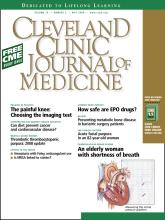ABSTRACT
The initial evaluation of acute knee pain should include plain radiography, which is a quick and cost-effective way to identify a wide range of problems, including fracture, degenerative changes, osteochondral defects, and effusions. Computed tomography (CT) is the test of choice to better delineate fractures in patients who have knee trauma. If the history and physical examination point to damage of the cartilage, the menisci, and the cruciate and collateral ligaments and arthroscopy is contemplated, then magnetic resonance imaging (MRI) is useful for evaluating these structures.
- Copyright © 2008 The Cleveland Clinic Foundation. All Rights Reserved.
- Monica Koplas, MD,
- Jean Schils, MD⇑ and
- Murali Sundaram, MD, MBBS
- Imaging Institute, Cleveland Clinic
- Head, Section of Emergency Radiology and Musculoskeletal Radiology, Imaging Institute, Cleveland Clinic
- Section of Musculoskeletal Radiology, Imaging Institute, Cleveland Clinic, and Professor of Radiology, Cleveland Clinic Lerner School of Medicine of Case Western Reserve University
- ADDRESS:
Jean Schils, MD, Imaging Institute, A21, Cleveland Clinic, 9500 Euclid Avenue, Cleveland, OH 44195.
ABSTRACT
The initial evaluation of acute knee pain should include plain radiography, which is a quick and cost-effective way to identify a wide range of problems, including fracture, degenerative changes, osteochondral defects, and effusions. Computed tomography (CT) is the test of choice to better delineate fractures in patients who have knee trauma. If the history and physical examination point to damage of the cartilage, the menisci, and the cruciate and collateral ligaments and arthroscopy is contemplated, then magnetic resonance imaging (MRI) is useful for evaluating these structures.
- Copyright © 2008 The Cleveland Clinic Foundation. All Rights Reserved.






